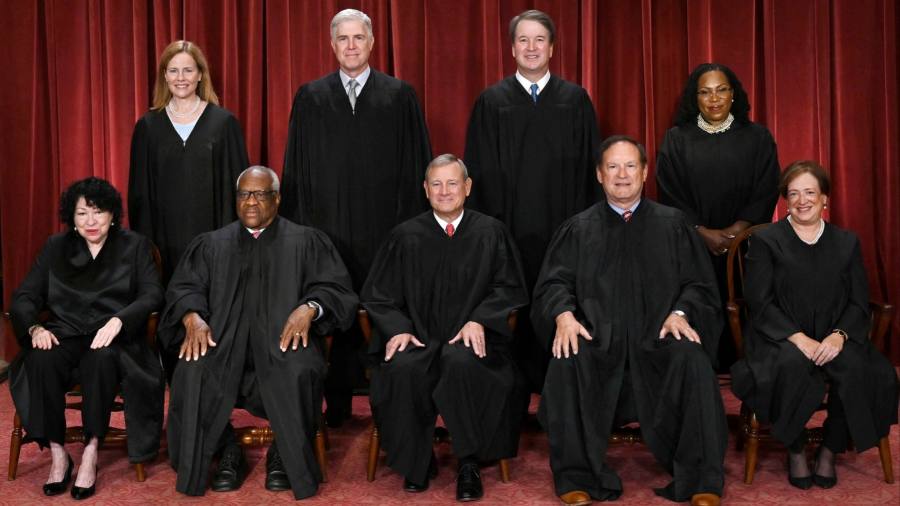
Receive free US politics & policy updates
We’ll send you a myFT Daily Digest email rounding up the latest US politics & policy news every morning.
The writer is a former member of the New York Times editorial board and author of ‘Supreme Inequality: The Supreme Court’s Fifty-Year Battle for a More Unjust America’
After Allan Bakke sued the University of California for rejecting him from medical school in 1974, conservatives tried for decades to end affirmative action in university admissions — and failed. Again and again, the Supreme Court upheld the use of race to promote diversity. That ended last month, when the court held that considering race in college admissions is unconstitutional.
The ruling, in a pair of lawsuits against Harvard and the University of North Carolina, was a huge victory for conservatives, but not the only one. The court also ruled that a Christian web designer could refuse to design websites for same-sex weddings. And it struck down President Joe Biden’s student loan forgiveness programme. These rulings built on major conservative wins from last year, the most notable of which was the court’s highly unpopular decision overturning Roe vs Wade. That ended nearly half a century of constitutional protection for abortion rights.
All but one of these landmark rulings was decided by a 6-3 vote (6-2 in the Harvard case, because of a recusal). These lopsided verdicts reflect an era of a conservative supermajority. These six justices have been aggressively reshaping the law — and society — to the detriment of minorities, women, gay people and the poor.
Today’s court is a conservative dream five decades in the making. From 1953 to 1969, the court was a strongly progressive force. Under Chief Justice Earl Warren, it dismantled Jim Crow, ordering schools and other public institutions to desegregate. And it protected the rights of women and poor people.
Richard Nixon arrived in the White House in 1969 vowing to end the liberal Warren court, and he did. In three years, he appointed four justices and built a conservative majority that continues to this day. The court Nixon created handed the right a long series of important wins. It stopped the push for more school desegregation. It tore out the heart of the Voting Rights Act by invalidating a key provision. And in Citizens United vs F.E.C., it ruled that corporations had a First Amendment right to spend money on elections.
But to the consternation of many conservatives, the court would not end abortion rights or affirmative action. There was always a moderately conservative swing justice — Sandra Day O’Connor or Anthony Kennedy — willing to vote with the liberal justices on both of those policies. After Donald Trump’s appointments to the court, all that changed. We now have what one commentator has called a YOLO (“you only live once”) court whose six-member supermajority did not flinch in overturning decades of abortion and affirmative action precedents.
The question is what pronouncements it will make next. Two areas the court may move further to the right on are again, affirmative action and abortion. On the former, it is not clear if the race-neutral principles the court laid out for college admissions apply in the same way to government and corporate hiring and minority contracting programmes. On the latter, lower courts are divided on whether the abortion pill mifepristone should remain available — court-watchers think the Supreme Court justices will end up deciding the drug’s fate.
The supermajority may want to maintain momentum by ending affirmative action in other parts of society and halting the use of mifepristone. Its ruling in the wedding website case could also signal further rollbacks of gay rights. Or the court might do none of these things. Some observers point to signs of moderation hidden behind the recent rulings: after years of hostility to the Voting Rights Act, the court gave civil rights advocates a major win in an Alabama congressional redistricting case.
Outside forces could also push the justices towards greater moderation. One is that respect for the court has plummeted. Only 25 per cent of Americans now have confidence in it, according to Gallup, a record low. Then there are the recent scandals over unreported gifts from billionaires to Clarence Thomas and Samuel Alito. If the Democrats retake the House, they could hold hearings on those gifts, and even consider impeachment. They have already introduced bills in Congress to impose term limits on the justices, and to expand the number beyond nine. These are long-shot proposals, but they make a point.
The court is at a crossroads. The supermajority can continue with its YOLO ways on civil rights, abortion, gay rights and other issues. Or it can pay attention to the large and growing popular backlash, and the damage it is doing to the court’s reputation, and start to slow its roll.